Ruger American Rifle — AR Mag-Fed Bolt Action in .223
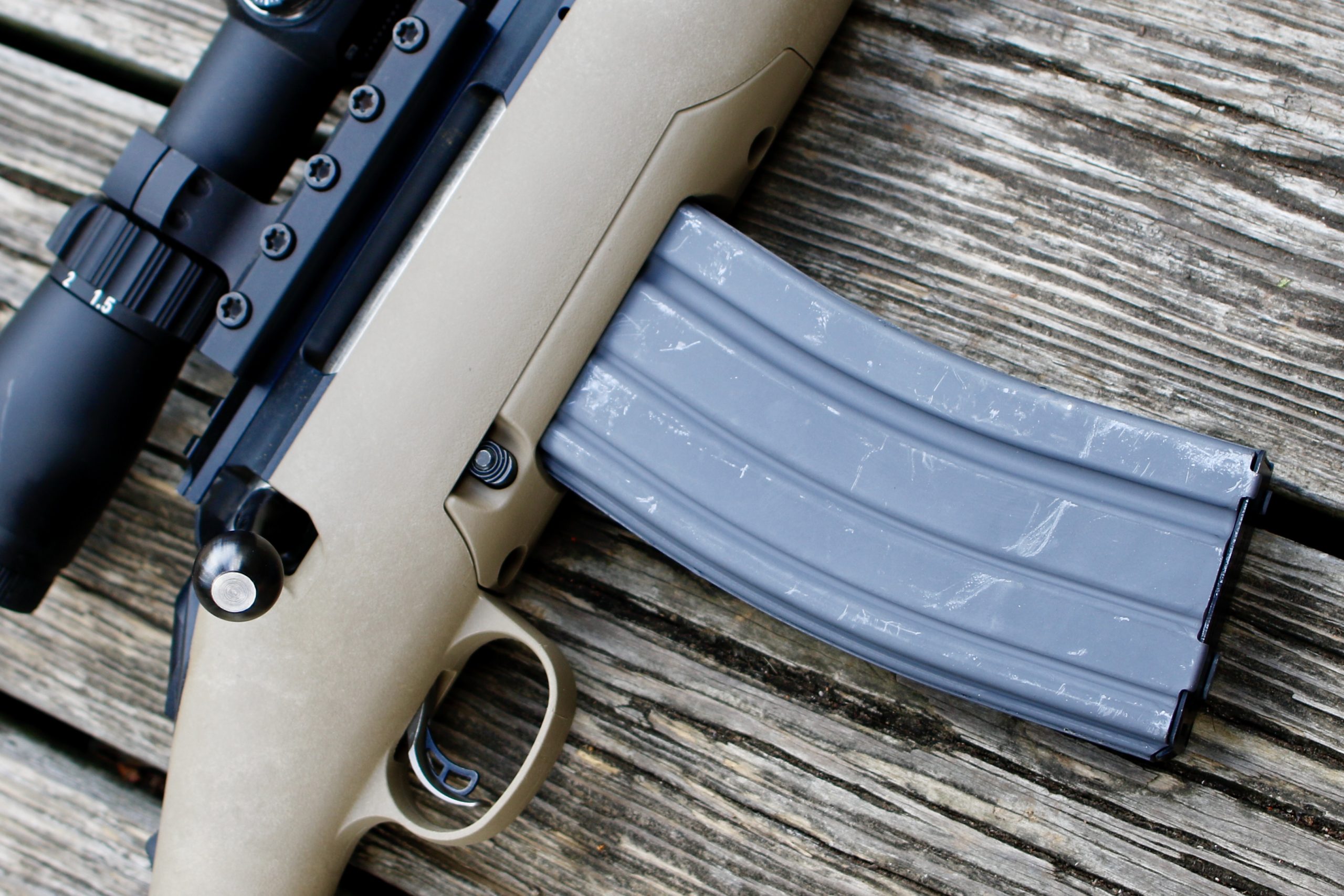
The existence of Ruger’s AR Magazine fed bolt action American Rifle isn’t news, but this is the first one I’ve been able to review and I think it is a gun that deserves some space in your safe. This little thing is versatile, light, and accurate. If you’re looking for a .223 that isn’t an AR, this is a compelling place to start.
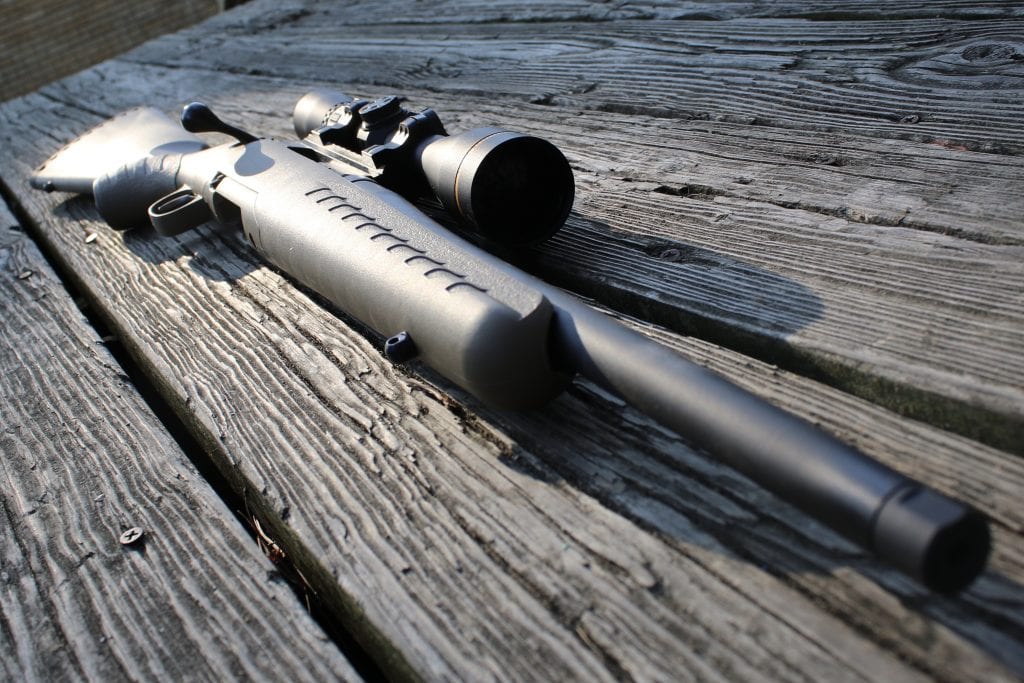
The Ruger American Rifle Ranch in .5.56 is an AR-magazine fed bolt action that is exceptionally versatile.
Ruger is notorious for making odd choices when it comes to magazines. Those of you with really long memories will know what I’m talking about. But they’ve been correcting many of those missteps, one by one, and this is the perfect example of Ruger getting it right.
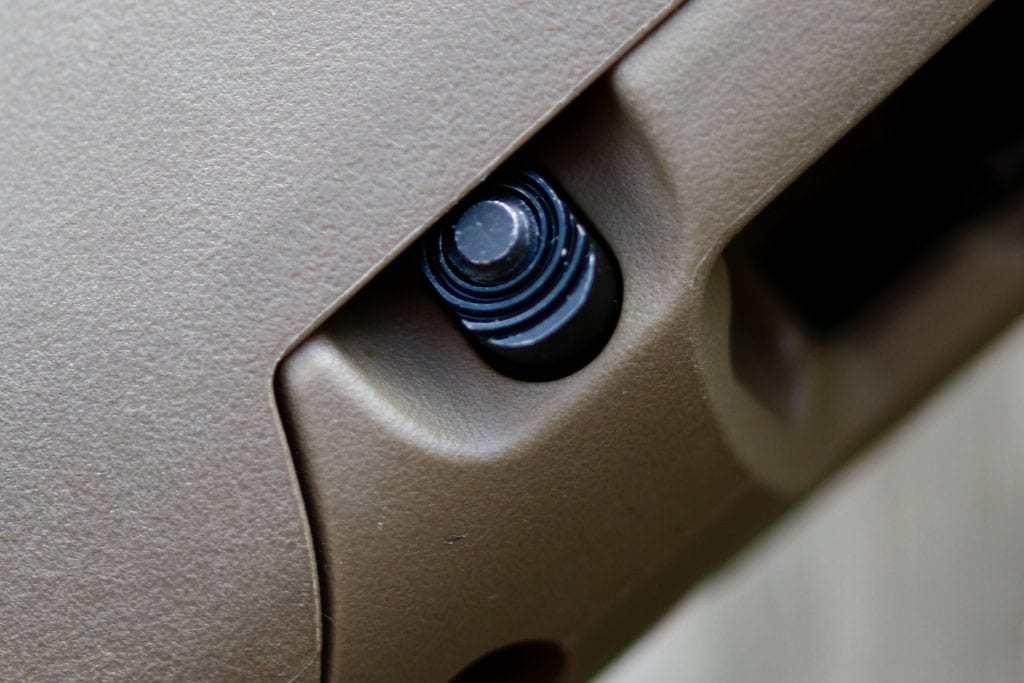
There’s still enough real estate exposed to ensure rapid magazine changes.
Make no mistake—the reason why we all come to this rifle with such enthusiasm is precisely because of its magazine options. But this gun has more going for it. For one, it is part of Ruger’s dynamic American Rifle line.
The Ruger American Rifle
When the American Rifle debuted, it was a functional, inexpensive gun. I worked on a review of one from that first iteration and we took it out to 1000 yards with little difficulty. For a sub-$400 rifle, it performed incredibly well.
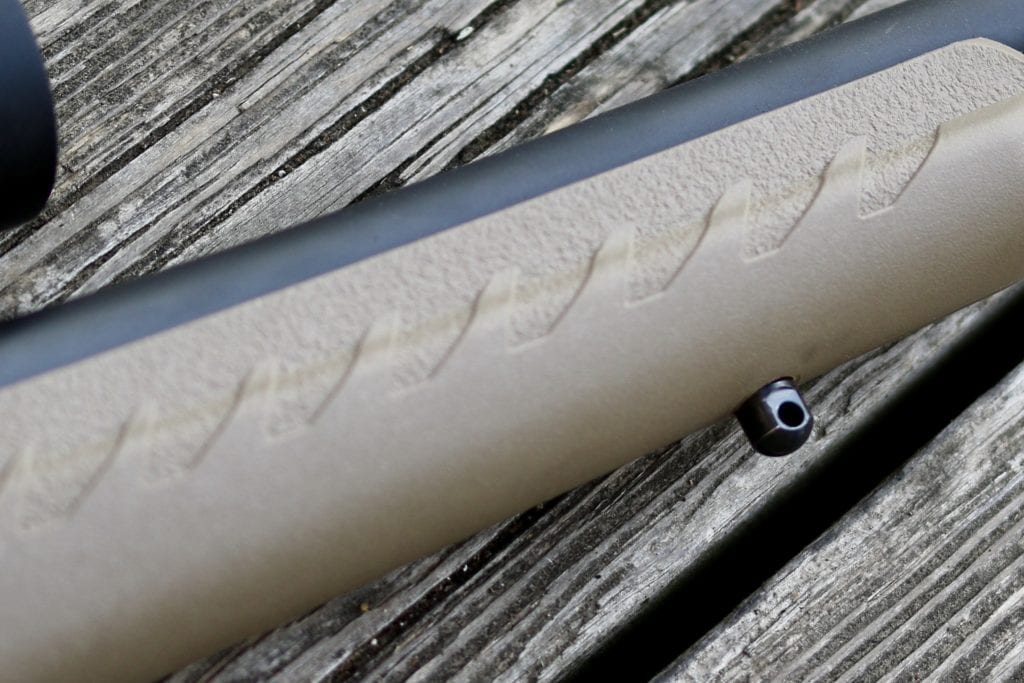
The texture is molded into the forend and isn’t as aggressive as it could be. It is slightly pebbly.
The American Rifle was positioned as an entry-level, budget-conscious gun. Their polymer stocks were simple, and often in simple colors. The barrels were thin, allowing for lighter builds. The action was simple enough, reliable, and efficient.
Ruger put the innovations they’d designed for many of their more expensive rifles into the design of the American rifle. One of the best was their manufacturing. They implemented Toyota-style assembly lines and took more manufacturing and milling in-house.
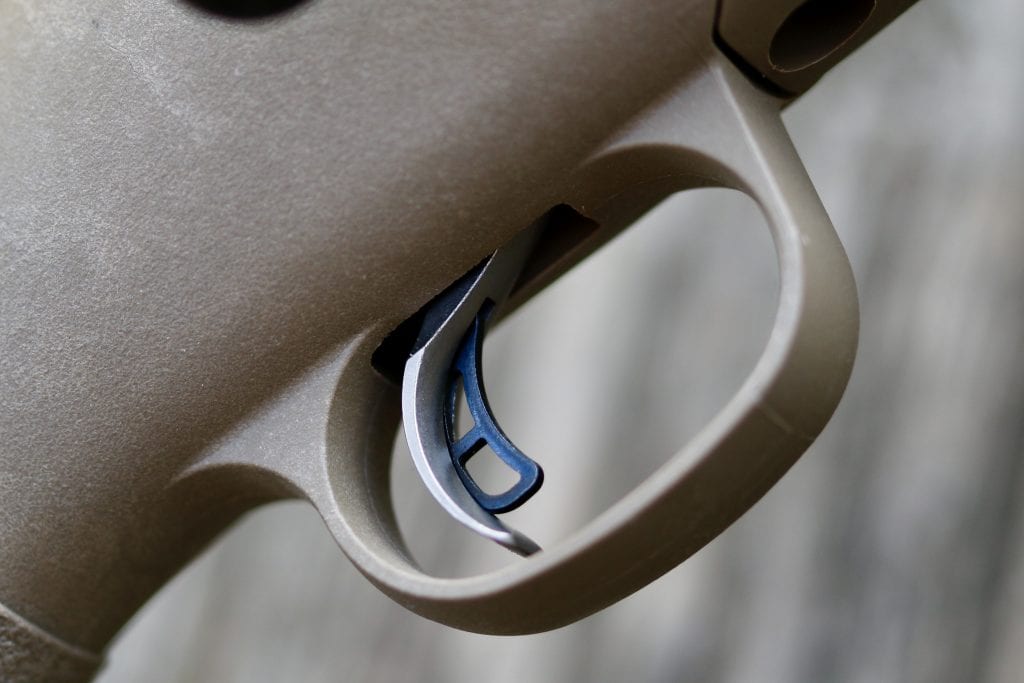
Even the trigger guard on the Ruger is polymer. But that makes for a solid, knock-around gun.
The guns coming off were ideal for ranch guns, hunting guns, truck guns…. If you needed a knock-about gun that could take a beating—one you wouldn’t have to treat like it was an heirloom in the making, the American rifle would fit the bill.
As the line evolved, Ruger expanded caliber offerings, barrel profiles, stock finishes, and added the extras like threaded barrels.
But an AR Magazine-Fed Bolt Action?
But the American Rifle worked with proprietary mags. And any true magazine aficionado knows, and we have a lot of them here at GunMag Warehouse, variety is the spice of life. We like unlimited choices, and proprietary magazines offer very little in the way of choice.
So Ruger designed the push-feed of the American Rifle to strip rounds off of an AR magazine. They retrofitted the stock to accept AR mags. The rest is bolt-action history.
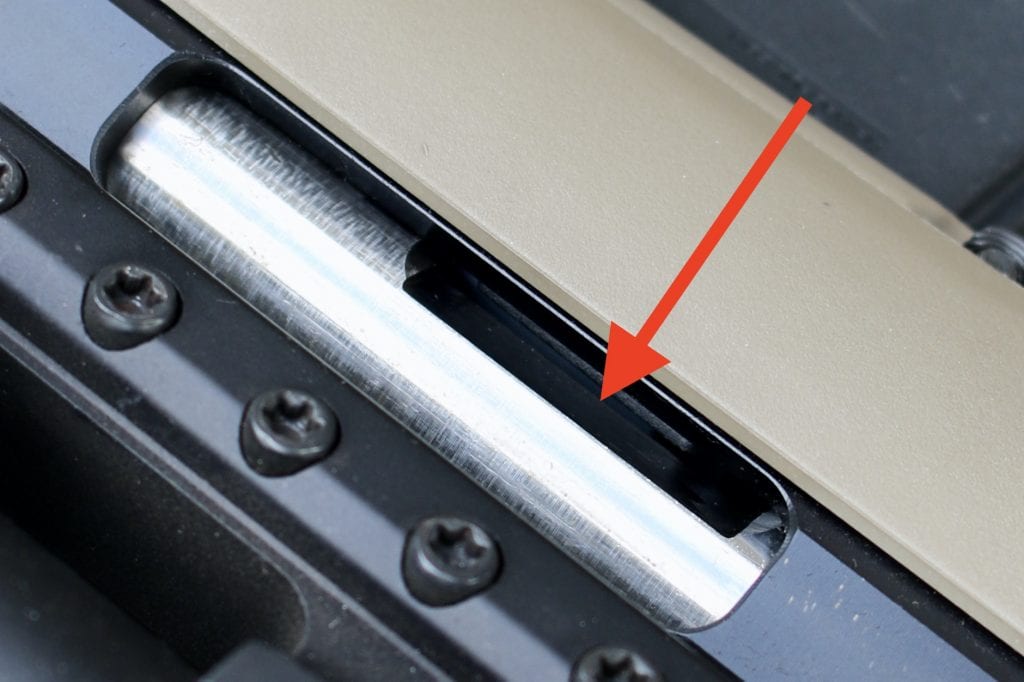
This is where the magic happens. Notice how the cut-out clears the top of the mag.
How Does it Work?
When the bolt is closed, there’s a recess that keeps it from contacting the case of the next-available round in the magazine—basically a cut-out in the bolt that lets the shooter manipulate the up-down motions without totally dragging on top of the first brass case in the magazine.
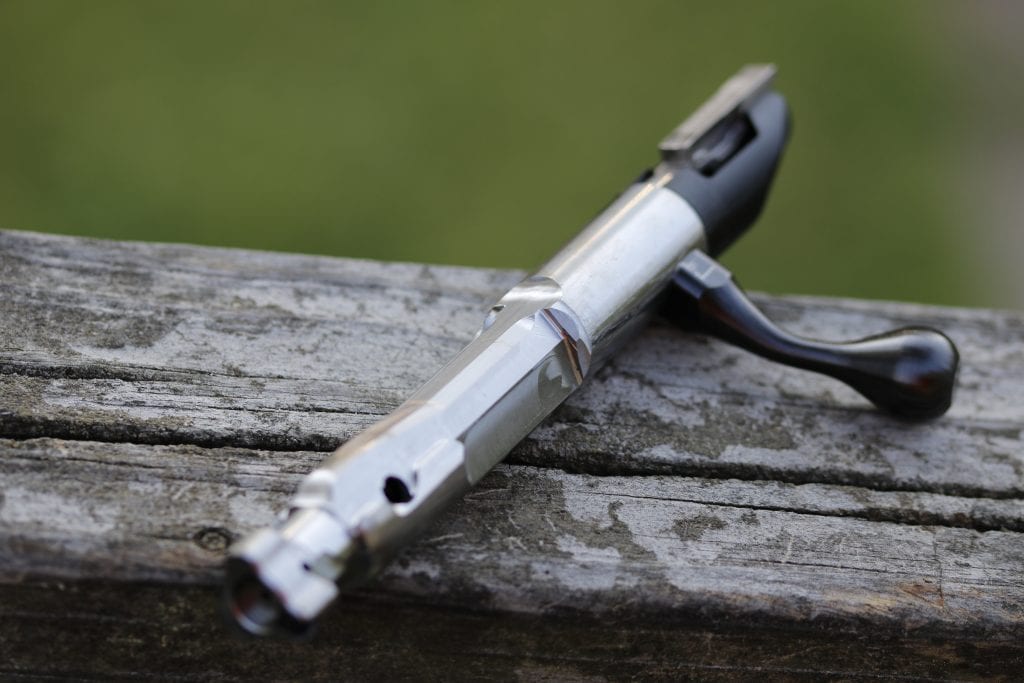
Ruger’s bolt design is unique and will strip rounds off of any AR mag. That makes this one of the most versatile bolt-guns around.
As you rack the bolt, it rotates over the next round. The rotation pushes down on the round, ever so slightly.
When you draw the bolt back, it rides over the next round. One of the three lugs—the one pointing down, obviously, rides off the end of the round, which pops back up in front of that same lug. The lug then pushes the case from the rear, seating it as you lock the bolt handle back in place.

The bolt has three lugs, which shortens the distance between locked and unlocked.
It isn’t all that different from how any push-feed works, really.
Here’s how it is summarized in their patent: “[…], the bolt body includes a reduced diameter middle section with specially angled/contoured surfaces in some embodiments to avoid the feed lips.
The diameter reduction and angled surfaces are minimized and restricted primarily to the middle section so that a substantially full diameter body is retained in the front and rear sections for adequate bolt support and aesthetic considerations so that the angled surfaces are not visible to the user when the bolt is closed.”
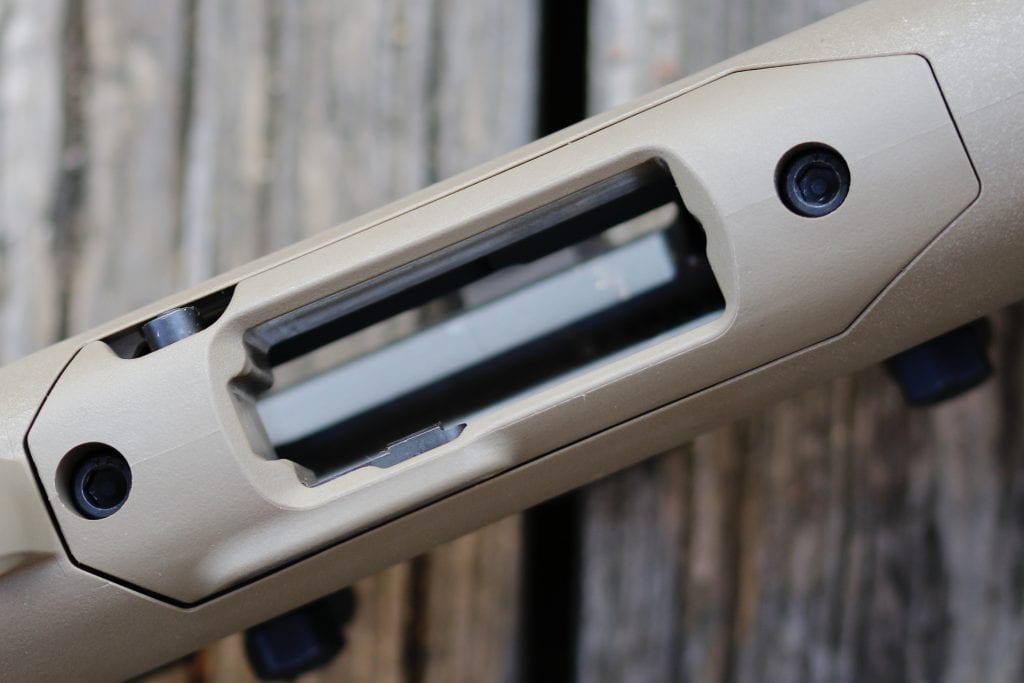
The mag-well is tight. This is a compromise that allows the aluminum mags and plastic mags to fit in the shortened well.
If you geek out over gun details, this patent—and all of the ones associated with the American Rifle, is a good read. It basically details how fat, two-lug bolts get hung up on feed lips, and how skinny three-lug bolts don’t have enough contact with rounds to feed correctly. The answer is Ruger’s fatter three-lug pattern with some strategically placed cutouts to relieve the stress during locking and unlocking and during the full motions of extraction and feeding.
The Hurdles of an AR Magazine-Fed Bolt Action
There is a bit of complexity, though, that Ruger has mastered. Remember the variety I mentioned earlier. Steel, aluminum, plastics of multiple densities—each produces a different width inside the mag well and chamber. As bolt-actions often have tighter tolerances than ARs, this can be a problem.
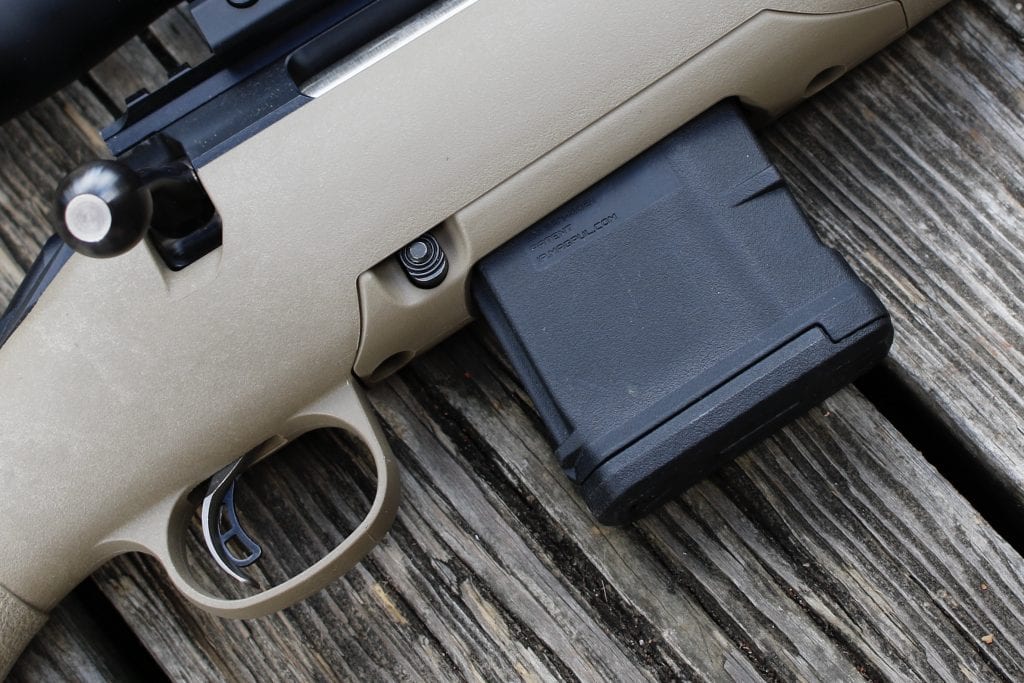
The Ruger American Rifle takes AR mags.
I ran a full selection of mags through. I found the polymer mags were tight going in and coming out. Anything metal fit in with more ease. Everything fed reliably, though.
The bolt can drag over the feed-lips of the magazine. A new shooter I was introducing to bolt-actions was practicing with the gun and had some complaints about the bolt not gliding in and out. It isn’t as smooth as it some actions—for sure.
I didn’t have the same experience, but that is likely because I approached bolt manipulation with more force. The action isn’t what I’d describe as delicate, and you really need to run-it-like-you-mean-it. When you do, bob’s your uncle.

The Ruger American has a tang safety.
One thing that is unique is the way the bolt locks open on an empty magazine. With three or four-round mags, this is hardly an issue. We can all count to four.
But on a 30 round mag, this is a solid feature. I’d say this was not quite as important as it would be on a semi-auto, but still a good feature.
Where Does this Gun Fit in the Ruger Lineup?
When I first began working with Ruger rifles, I really wanted to like the Mini-30. That seemed like an exceptionally functional truck gun. I liked it fine, but I never was happy with the magazine. The same held true for the Mini-14. It seemed to me to be a missed opportunity.
This, though, is different. This rifle is perfect. It isn’t precious, in any way. It will run off of any AR mag. From the shortest of the shorts, through the ones that would be especially absurd in a bolt-action—they all work. I like this setup, too. The heavier barrel—cut short and threaded—is really quite versatile.
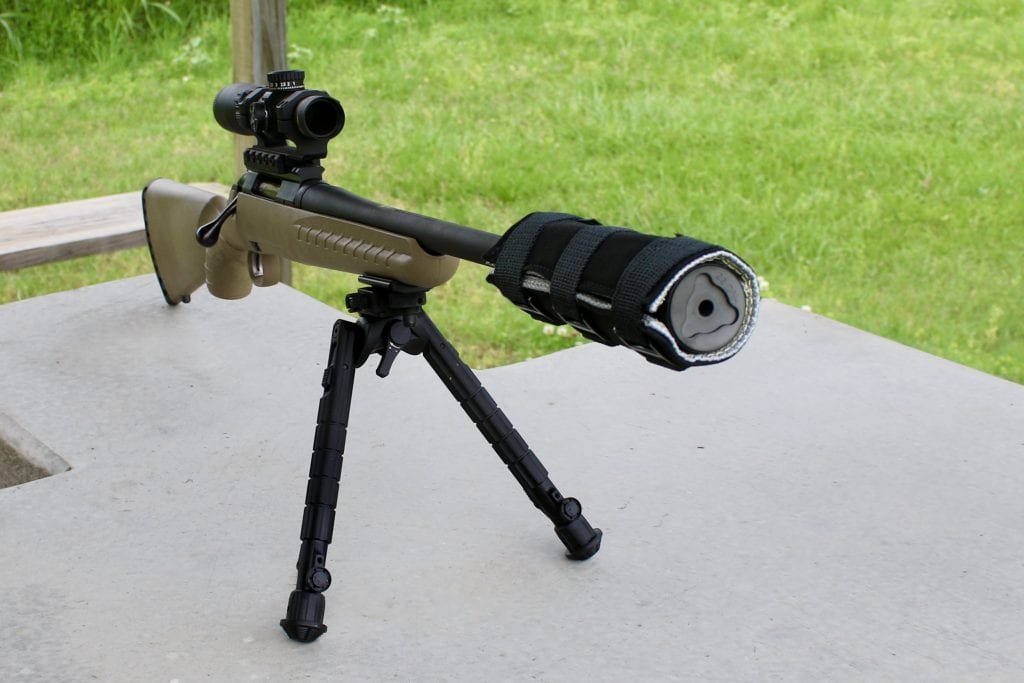
The Ruger American Rifle with a Banish .223 is still exceptionally light. This is a lean set-up.
It is loud, too–so take it to the next level and suppress it. Or invest in some really good hearing protection. Regardless, don’t stand out beside it to take pictures while someone else is shooting it–it’ll rattle your teeth loose.
Which Mags?
The mag doesn’t matter—and that’s the beauty of an AR Magazine fed bolt action. I ran some aluminum mags, and they worked exactly like they should.
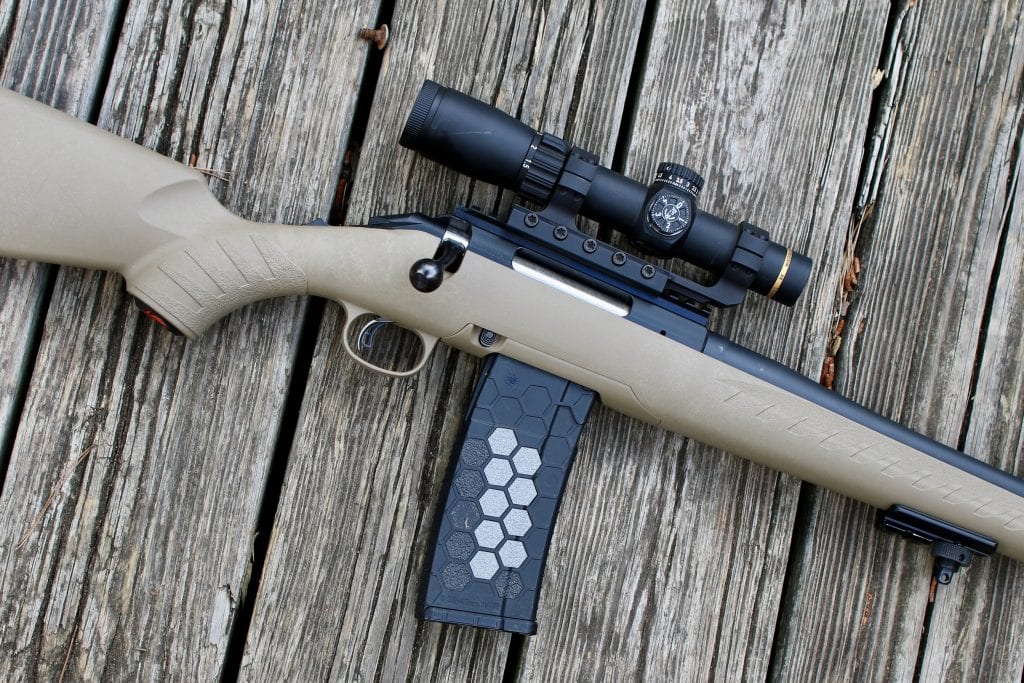
Hexmags work, too. The 30 round mags are a bit long for a bolt-action, unless you shoot standing.
I also ran some polymer mags—both Hexmags and Magpul mags in 10 and 30 round capacities. They all worked exactly as I’d hoped they would.
My 14-year-old is pushing me to get a big-ass-drum mag for it, but I’m fine with 30. Unless the drum might substitute for a shooting rest, which is an angle I haven’t really considered yet.
30 round mags are standard and easy to come by. They’re also perfect for this platform—if a tad long for some shooting positions. Just like with any AR-15, you’re going to fight the magazine if you go prone or shoot from the bench.
There are 5 and 10 round mags available, and those are ideal for bellying out and getting low. In these shooting positions (and unlike with some ARs) you can use your mag as a mono-pod of sorts. Putting tension on a mag like this can be trouble for a semi-auto, but you’re in control here and you can pull off the tension on the magazine when racking the bolt, so there’s nothing to get upset about.
The Elephant in the Room
As elephants go, this one is big. Bigger than big. And maybe a bit more aggressive.
If you’ve been paying attention lately, you know there are politicians who don’t want even the most law-abiding among us to have AR-15s. They’ll attack the guns, the ammo, the accessories—even make assertions about how no “self-respecting” hunter would ever use a semi-auto for hunting. This is, they claim, only a weapon of war.
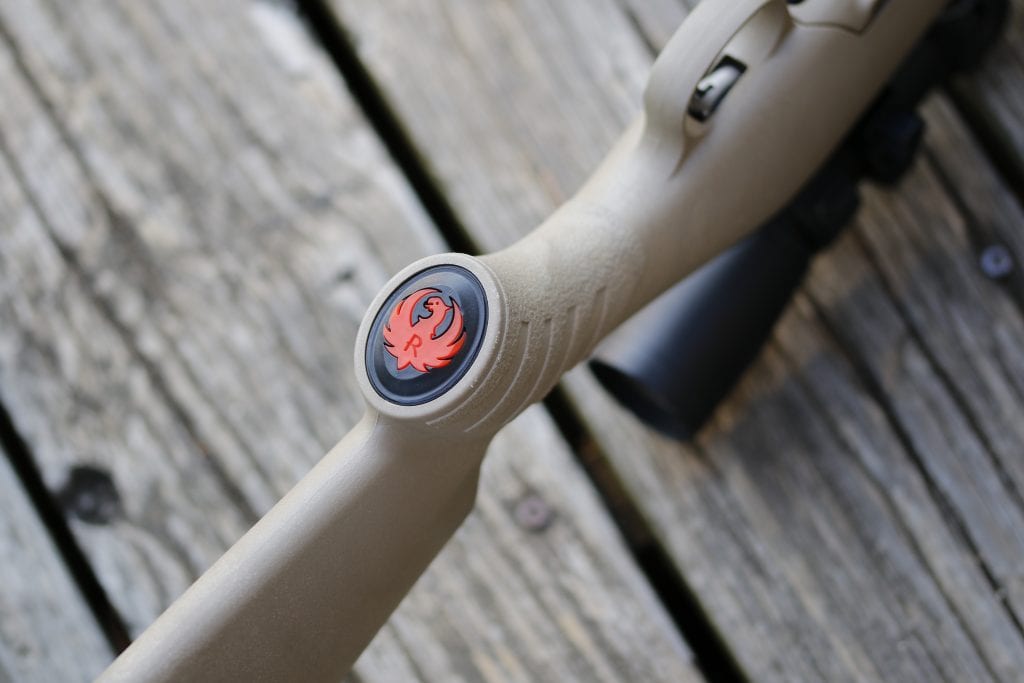
The only overt branding on the Ruger is this heel cap below the grip.
ARs remain popular, though. I realize I’m preaching to the choir. And .223 remains a viable caliber for many purposes, including hunting.
Then there are the mags. AR mags are everywhere. There are more varieties of that one style of magazine than any other in the entire history of magazines.
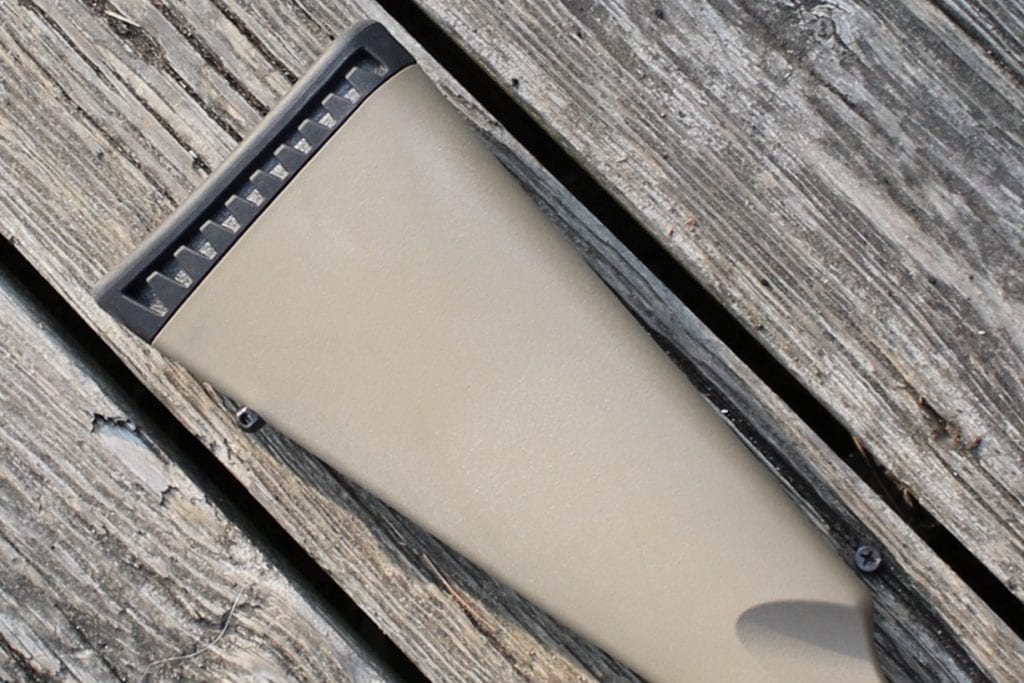
The Ruger American Rifle’s stock and butt-pad are functional, traditional, and no-frills.
Part of the appeal of the Ruger American Rifle plays on exactly that. If there were to be catastrophic legislation enacted that would infringe upon our rights, many of us would still have a lot of .223 (and possibly a large number of mags) sitting unused.
But what if the elephant in the room doesn’t materialize?
For many—and I do mean a lot of us—the Ruger is interesting because it takes AR mags. But this is a damn functional gun regardless. While the short barrel takes some of the punch out of the .223, it is still accurate at moderate distances. And it is light enough to carry all day without feeling fatigued.
I’d say this was an ideal set-up for any prepper concerned with keeping a dot-it-all gun close at hand. In those scenarios, .223 will be the easiest ammo to find.
For ranchers, this would be a solid choice for a varmint gun. Hogs, coyotes, groundhogs… this is a great bolt action to keep on the ATV or behind the seat in the truck.
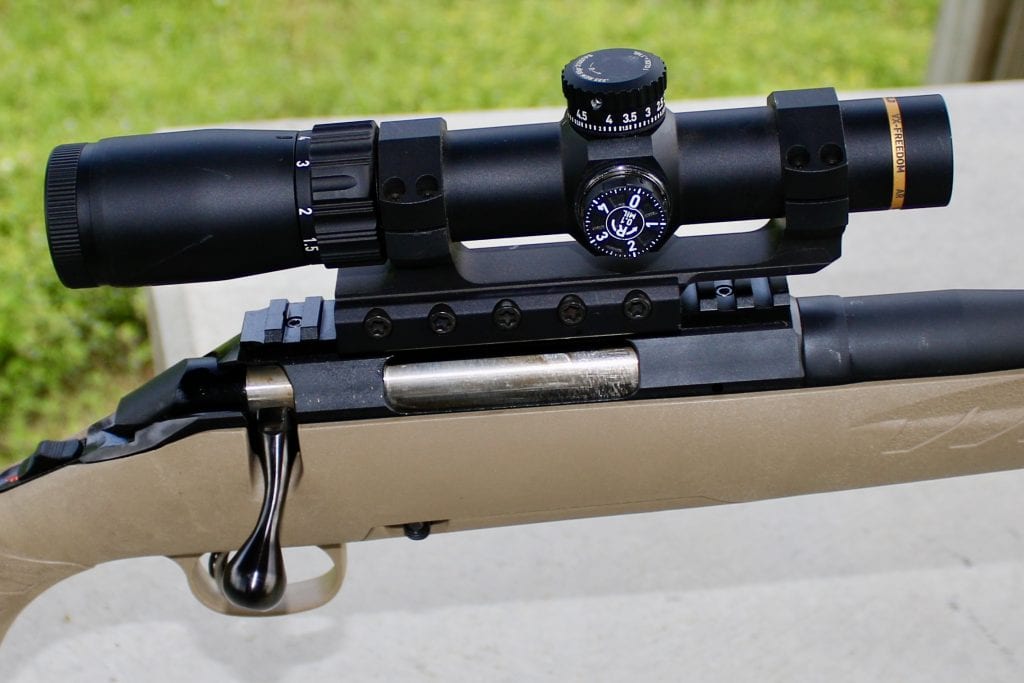
The .223 has stopping power at extended range, but I prefer to keep shots under 300 yards. The Leupold VX-Freedom 1.5-4 is ideal for fast, close work.
For anyone looking for a range gun for training, this one has a ton of potential. .223 is inexpensive and there are numerous ways–even in this market–to train on the cheap.
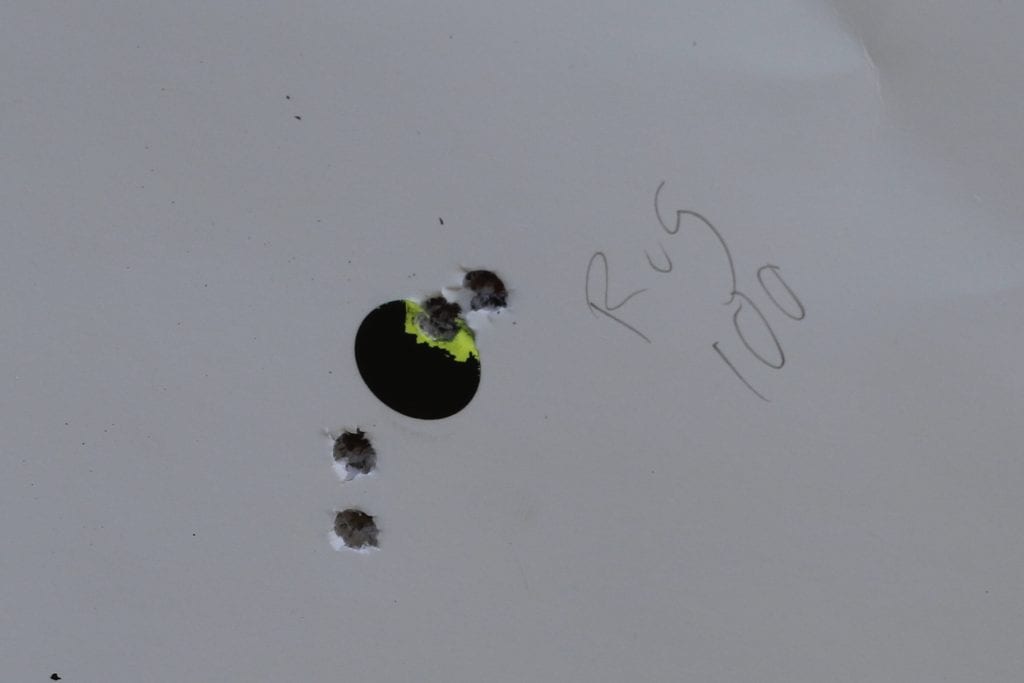
Four shots in rapid succession from 100. The first two were dead on, then the second two drifted down and out.
And then there’s the general do-it-all nature of the gun. With so many different kinds of .223 on the market (grain-weights, bullet shapes, bullet materials), this is a gun that can adapt.

The Ruger American from 200 yards with 55 grain 5.56.
Actually, this gun is chambered in 5.56, so there’s even more variety available. It has a 1:8 twist down the 16-inch barrel, so bullets will make two rotations before leaving the barrel. A 1:8 ratio is decent enough for light 55-grain rounds but really shines with those between 62 and 77 grains.
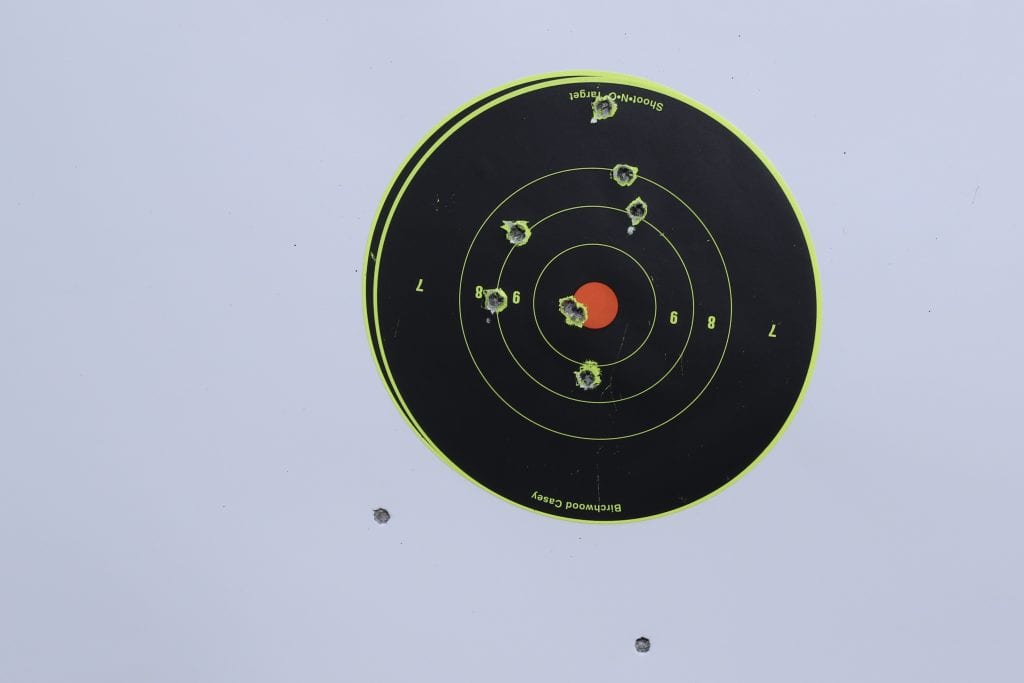
10 rounds fired fast, from the shoulder, at 100. The Ruger American Rifle platform is versatile.
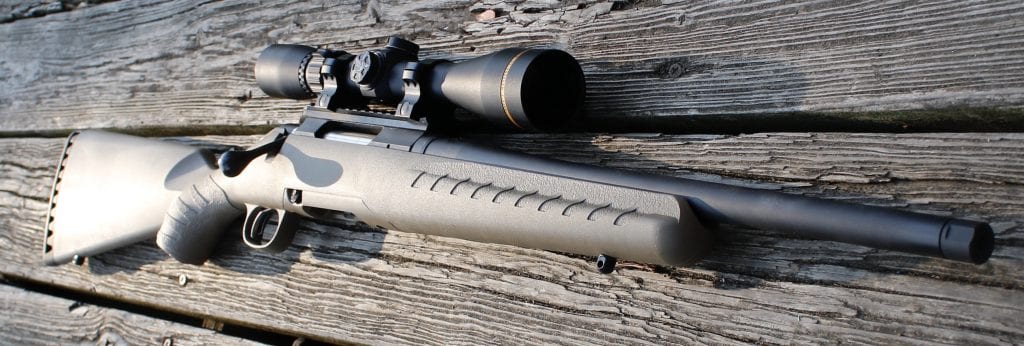
For a compact rifle that can shoot a wide variety of ammo from a vast array of magazines, the Ruger American Rifle in .223 delivers.
So What Will it Cost?
If you can find one these days, in this market, MSRP is $549. There are bolt-actions that sell for less, and some in .223, but few with the functionality of this version. In a standard market (kind of like 2018/2019), this would have come in well under that MSRP.
David Higginbotham is a writer and editor who specializes in everyday carry. David is a former backcountry guide in the Sangre de Cristo Mountains and Boundary Waters Canoe Area who was a college professor for 20 years. He ultimately left behind the academy for a more practical profession in the firearms industry and was (among other editorial positions) the Managing Editor for a nascent Mag Life blog. In that Higginbotham helped establish The Maglife’s tone and secure its early success. Though he went on to an even more practical firearms industry profession still, he continues to contribute articles and op-eds as time and life allow.



